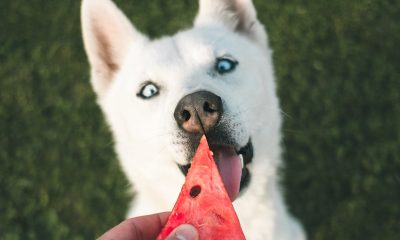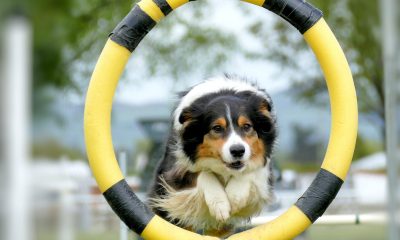Dog Training
The Importance of Teaching Your Dog Impulse Control

If you want a well-behaved and happy dog, teaching them impulse control is essential. By helping your furry friend learn to make better choices, you can prevent negative consequences and build a stronger relationship.
With impulse control training, you can create a safe and harmonious living environment for both you and your dog. In this article, we’ll explore tips and techniques for training impulse control in dogs, so you can serve your pup’s needs and create a peaceful home.
The Negative Consequences of Lacking Impulse Control
You need to be aware of the negative consequences of lacking impulse control. Understanding the psychology behind impulse control in dogs is crucial in order to implement effective training methods. Dogs who lack impulse control can engage in a range of undesirable behaviors that can hinder their ability to serve others.
When a dog lacks impulse control, they may exhibit behaviors such as jumping, barking excessively, or pulling on the leash. These actions can be disruptive and make it difficult for the dog to perform their tasks effectively. For example, a service dog who lacks impulse control may become easily distracted or overly excited, making it challenging for them to stay focused on their handler’s needs.
Implementing impulse control training in different environments is essential to ensure that dogs can remain calm and composed in various situations. By teaching dogs to wait patiently, resist temptations, and make thoughtful choices, they can develop the self-control needed to serve others effectively.
Without proper impulse control, dogs may struggle to fulfill their duties and may even pose a risk to themselves or those around them. It’s crucial for dog owners and trainers to prioritize impulse control training to help dogs become well-behaved and reliable companions who can serve others with confidence and composure.
Building a Stronger Relationship Through Impulse Control Training
By incorporating impulse control training into your daily routine, you can strengthen your relationship with your dog and foster a deeper sense of trust and cooperation. Training your dog to have impulse control is essential for enhancing their behavior and creating a stronger bond between you and your furry companion.
Here are three benefits of teaching your dog impulse control:
- Reducing unwanted behaviors: Impulse control training helps your dog learn to resist the urge to engage in behaviors such as jumping, barking excessively, or begging for food. By teaching them to wait patiently and remain calm, you can eliminate these unwanted behaviors and create a more peaceful and harmonious environment for both you and your dog.
- Promoting better decision-making: Through impulse control training, your dog learns to make better choices. They learn to think before acting and to respond to your commands, which can prevent them from getting into dangerous situations or engaging in activities that may be harmful to themselves or others.
- Strengthening the bond: Impulse control training requires communication and cooperation between you and your dog. By working together to overcome challenges and achieve goals, you build a stronger bond based on trust and mutual understanding. This enhanced bond not only improves your dog’s behavior but also deepens the connection between you and your loyal companion.
Teaching Your Dog to Make Better Choices
When teaching your dog to make better choices, it’s important to be consistent and patient, even when faced with challenging situations. Using reward-based training methods, you can help your furry friend develop impulse control and make decisions that are more aligned with your expectations.
Dogs, just like humans, have their own set of impulses and instincts. By teaching them to manage these impulses, you can foster a stronger relationship and create a well-behaved companion.
Consistency is key in training your dog to make better choices. By setting clear boundaries and consistently reinforcing positive behaviors, you can help your dog understand what’s expected of them. Patience is also crucial, as it takes time for dogs to learn and change their behaviors. Remember to celebrate small victories and acknowledge progress along the way.
Reward-based training methods can be highly effective in teaching your dog to make better choices. By rewarding desired behaviors with treats, praise, or playtime, you can encourage your dog to repeat those behaviors in the future. This positive reinforcement helps your dog associate making better choices with positive outcomes, making them more likely to make those choices again in the future.
Creating a Safe and Harmonious Living Environment
It’s important to establish clear rules and boundaries in order to create a safe and harmonious living environment for everyone in the household. By setting these guidelines, you can improve obedience and prevent accidents, ensuring the well-being of both you and your loved ones. Here are some key points to consider:
- Consistency: Consistently enforce the rules to help your household members, including pets, understand what’s expected of them. This will lead to a more obedient and well-behaved living environment.
- Positive Reinforcement: Use positive reinforcement techniques to encourage desired behaviors. Rewarding good behavior with praise or treats will motivate household members, both human and furry, to follow the rules.
- Safety Measures: Take necessary precautions to prevent accidents. Secure potentially dangerous items, such as chemicals or sharp objects, out of reach. Install safety gates or locks to protect children or pets from accessing hazardous areas.
Tips and Techniques for Training Impulse Control in Dogs
To improve your dog’s impulse control, practice the ‘wait’ command during mealtime. Teaching patience is essential for your furry companion’s overall well-being and safety. By incorporating this training technique, you can ensure that your dog learns to manage distractions and wait patiently for their food.
Begin by holding your dog’s food bowl and saying ‘wait’ in a firm yet gentle tone. Slowly lower the bowl towards the ground, but be prepared to lift it up if your dog tries to snatch it. Reinforce the ‘wait’ command by using a hand signal, such as an open palm facing towards your dog.
It is crucial to remain consistent and not give in to their impulsive behavior. Reward your dog with praise and a treat only when they remain calm and wait for your signal to eat. Gradually increase the duration of the ‘wait’ command, starting with a few seconds and eventually working your way up to several minutes.
Remember to create an environment free from distractions during mealtime. This will help your dog focus solely on the ‘wait’ command and not get sidetracked. As your dog becomes more proficient, you can introduce distractions gradually, teaching them to maintain their patience even in the presence of tempting stimuli.
By practicing the ‘wait’ command during mealtime and managing distractions, you can teach your dog valuable impulse control skills. This training not only enhances their behavior but also strengthens the bond between you and your furry friend.
Frequently Asked Questions
Can Impulse Control Training Help With Other Behavioral Issues in Dogs?
Impulse control training can benefit dogs with aggression issues by teaching them to pause and think before reacting. It can also help dogs with separation anxiety by teaching them to remain calm when separated from their owners.
How Long Does It Usually Take to See Results From Impulse Control Training?
Impulse control training can have noticeable results within a few weeks. To measure progress, track how long your dog can resist a temptation. Overcoming challenges? Keep training sessions short and use high-value rewards.
Are There Any Breeds That Are More Prone to Struggling With Impulse Control?
Some breeds are more prone to struggling with impulse control. However, with proper training techniques, you can improve your dog’s impulse control regardless of their breed. It just takes time and consistency.
Can Impulse Control Training Be Effective for Older Dogs?
Impulse control training can greatly benefit older dogs. Incorporate it into everyday activities like mealtime or walks. This can help them make better choices and be more well-behaved, making your life easier and their life happier.
Is It Possible to Train a Dog to Have Perfect Impulse Control or Is It More About Managing and Improving Their Behavior?
You can train your dog to have better impulse control by using effective training techniques. It’s not about perfection, but about managing and improving their behavior. Teaching impulse control in dogs is important for their overall well-being.
-

 Dog Food3 years ago
Dog Food3 years agoWhat Is The Best Food To Feed Puppies
-

 Dog Food3 years ago
Dog Food3 years agoWhat’s The Best Food For Dogs With Sensitive Stomachs?
-

 Health Issues3 years ago
Health Issues3 years agoA Growing Epidemic: Tackling Obesity in Dogs with Diet and Exercise
-

 Health Issues3 years ago
Health Issues3 years agoWhat Is Canine Chronic Bronchitis?
-

 Health Issues3 years ago
Health Issues3 years agoRecognizing and Treating Common Skin Conditions in Dogs
-

 Health Issues3 years ago
Health Issues3 years agoHow to Prevent Heat Stroke in Dogs
-

 Dog Food3 years ago
Dog Food3 years agoWhat Are The Healthiest Dog Foods
-

 Health Issues3 years ago
Health Issues3 years agoRecognizing And Treating Urinary Tract Infections in Dogs































































